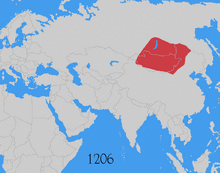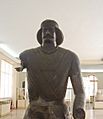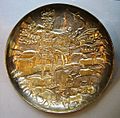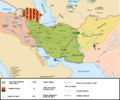History of Iran facts for kids
Iran is home to one of the world's oldest continuous major civilizations, with historical and urban settlements dating back to 4000 BC. The Medes unified Iran as a nation and empire in 625 BC.
The Islamic conquest of Persia (633–656) and the end of the Sassanid Empire was a turning point in Iranian history. Iran had been a monarchy ruled by a shah, or emperor, almost without interruption from 1501 until the 1979 Islamic revolution, when Iran officially became an Islamic Republic on 1 April 1979.
Pre-Islamic

Before Iran was called Iran, and before Iranians lived there, a different group of people lived in Iran. These people were called the Elamites. The Elamites are mentioned in the Bible. The Elamites lived in a kingdom called Elam. Elam was conquered by Iranian peoples, such as the Medes (a type of Iranian), because the Elamites became weak after fighting the Assyrian people (a different people) for too long. The Iranians would then go on to conquer the Assyrians, as well.
The name Iran comes from Aryan and is also mentioned in the ancient book of the Zoroastrians, which was called the Avesta. Iran means "Aryan" in Persian. In the 19th and early 20th century, the name Aryan was used by Europeans to mean all Indo-Europeans.
Around 500 BC, present-day Iran was the center of the Persian Empire. Then, Alexander the Great took the country by fighting and the Achaemenid dynasty of Persia later ruled. After them the Sassanian dynasty (224-651) took over.
Islamic Persia

Other people took Persia by fighting, like the Arabs (7th century), Turks (10th century) and Mongols (13th century). However, Iran has always maintained a distinct culture and continued to survive.
The Safavid dynasty (1502-1736) made Islam and Shi'a the state religion of Iran although Islam was already popular then. The latest kings of Iran were from the Pahlavi dynasty, and ruled from 1925 until 1979, when there was a revolution and Ayatollah Khomeini created an Islamic republic.
In 1951, Mohammed Mossadegh was brought to power after being elected as prime minister by nearly all members of the Majlis (parliament) in Iran. His first act in office was to take control of the oil industry in Iran which had been controlled by Great Britain. Most of Britain's oil was pumped from Iran at the time. This move was seen as a danger to Great Britain's security and empire, so they tried to overthrow the government but failed. After this they convinced the United States through diplomacy that the government of Iran was a communist threat.
The CIA worked in Iran to create riots which led to the removal of Prime Minister Mossadegh. The United States and Great Britain then made the Shah Mohammad Reza Pahlavi King of Iran, again.
Islamic Republic
The Shah ruled in Iran for 38 years. When he left Iran the Iranian government was changed to an Islamic Republic by Islamic Revolution. Soon afterwards, Iranian Students Movement (Tahkim Vahdat), with the backing of the new government took over the U.S. Embassy in Tehran and held most of the diplomats hostage for 444 days. Relations between the two countries have not been good since. For example. The US has imposed various types of economic sanctions against Iran. The US claims the Iran supports terrorist groups against Israel. Iran does not recognize Israel as a state. Iran, along with most Arab countries believe that Israel does not have the right to occupy the land of Palestinians.
Iran has long borders in common with Iraq. (The words "Iran" and "Iraq" are similar only in Latin alphabet. In Arabic and Persian, they are written differently.) Iranians are ethnically not Arabs. Iran defended itself against Iraqi invasion in 1980, a war that lasted eight years. Many Arab and Western countries, including the United States provided weapons (including biological and chemical weapons of mass destruction) and technical support for Iraq's Saddam Hussein.
Now, the West is trying to prevent Iran from mastering nuclear technology, even though Iran is a member of the NPT. They voice their concern claiming that Iran's intention is to develop nuclear weapons. The International Atomic Energy Agency (IAEA) has reported numerous times that there is no evidence that Iran is developing nuclear weapons, however, it also says that it can not say for sure that Iran is not doing so in secret. A CIA report on nuclear activity in Iran, in December 2007 claimed that Iran's secret program to achieve nuclear weapons technology was stopped in 2003, and that since then, it was never restarted. It reports that Iran's ability to build a nuclear weapon will probably not happen soon.
The presidential elections of 13th June 2009 were officially won by the existing president M. Ahmadinejad, but certain people do not believe this is true. There were demonstrations because of these results, and some protesters fought with police forces. Many people who demonstrated thought that the election was a fraud. Officially nine people died during the protests.
Images for kids
-
Chogha Zanbil is one of the few extant ziggurats outside of Mesopotamia and is considered to be the best preserved example in the world.
-
A panoramic view of Persepolis
-
The Seleucid Empire in 200 BC, before Antiochus was defeated by the Romans
-
Bronze Statue of a Parthian prince, National Museum of Iran
-
Rock-face relief at Naqsh-e Rustam of Iranian emperor Shapur I (on horseback) capturing Roman emperor Valerian (kneeing) and Philip the Arab (standing).
-
Hunting scene on a gilded silver bowl showing king Khosrau I.
-
Battle between Heraclius' army and Persians under Khosrow II. Fresco by Piero della Francesca, c. 1452.
-
The Saffarid dynasty in 900 AD.
-
Babak Khorramdin was the leader of the Khurramīyah movement. A devout Zoroastrian, he led the Persian freedom movement against oppressive Arab rule.
-
Eurasia on the eve of the Mongol invasions, c. 1200
-
Imam Reza shrine, the tomb of the eighth Imam of the twelver Shiites
-
Detailed map of the Timurid Empire with its tributary states and sphere of influence in Western-Central Asia (1402-1403)
-
Forensic facial reconstruction of Turco-Mongol conqueror Timur from skull, performed by the Soviet archaeologist and anthropologist Mikhail Mikhaylovich Gerasimov (1941)
-
The Aq Qoyunlu confederation at its greatest extent.
-
The Safavid Empire at its greatest extent
-
Როსტომ ხანი.gif
Rostom (also known as Rustam Khan), viceroy of Kartli, eastern Georgia, from 1633 to 1658
-
Persian Cossack Brigade in Tabriz in 1909
-
Tehran men celebrating the 1953 Iranian coup d'état
-
Ayatollah Khomeini returns to Iran after 14 years exile in France on 1 February 1979.
-
Mohammad Khatami, reformist President of Iran from 1997 to 2005
-
The tomb of Cyrus the Great
-
Mihr 'Ali (Iranian, active ca. 1800–1830). Portrait of Fath-Ali Shah Qajar. Brooklyn Museum.
-
Qajar era currency bill with depiction of Naser al-Din Shah Qajar.
-
A map of Iran under the Qajar dynasty in the 19th century.
-
A map showing the 19th-century northwestern borders of Iran, comprising modern-day eastern Georgia, Dagestan, Armenia, and the Republic of Azerbaijan, before being ceded to the neighboring Russian Empire by the Russo-Iranian wars.
-
Painting showing the Battle of Sultanabad, 13 February 1812. State Hermitage Museum.
See also
 In Spanish: Historia de Irán para niños
In Spanish: Historia de Irán para niños











































